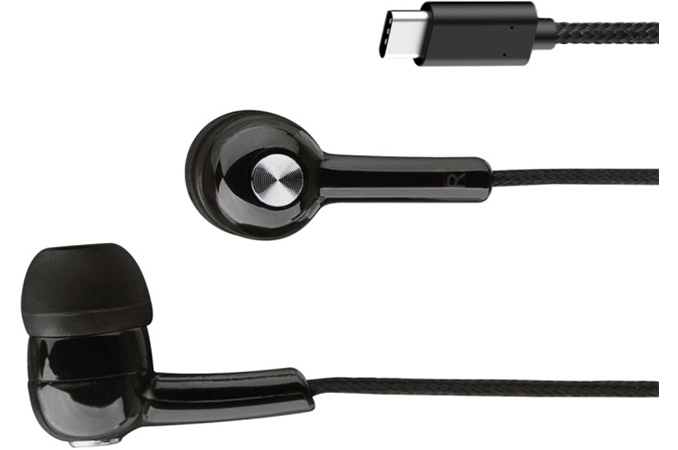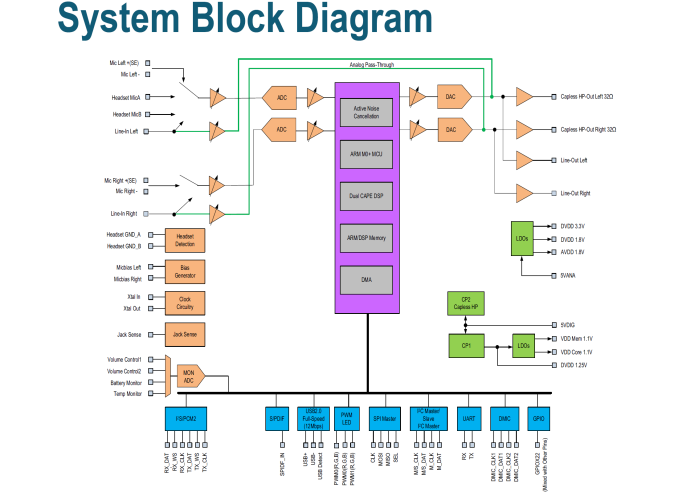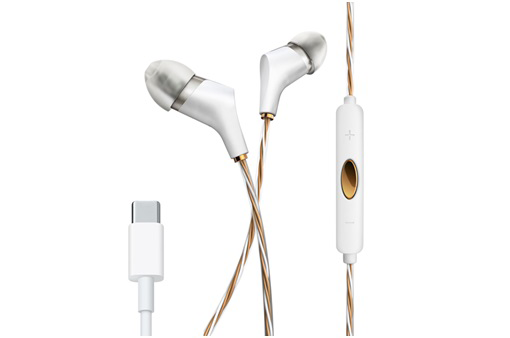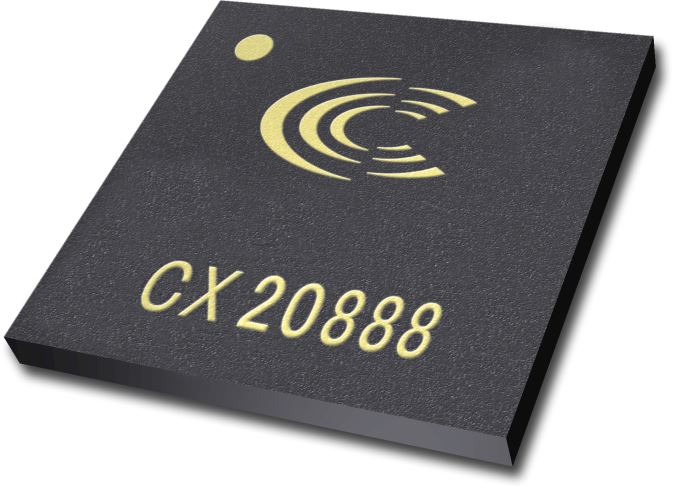Conexant Reveals CX20888: A New Chip for USB-C Headsets with Advanced Functionality
by Anton Shilov on June 29, 2016 1:40 PM EST- Posted in
- Mobile
- Intel
- Conexant
- USB-C
- USB-C Digital Audio

Conexant on Wednesday introduced its third CODEC for upcoming digital headsets using a USB Type-C interface. The new CX20888 chip is specifically tailored for headsets and supports a variety of advanced features, such as a headphone amplifier, active noise cancellation, sampling rates up to 96 kHz and so on. The company unveiled the product at the Mobile World Congress Shanghai in a bid to attract the attention of Chinese makers of consumer electronics.
The Conexant CX20888 is built around an ARM Cortex-M0 controller core (clocked at 50 MHz) and is equipped with two 32-bit Conexant DSPs (both clocked at 100 MHz) with floating point assist—bringing the total compute power of the DSPs to 400 MIPS—as well as 504 KB of SRAM that's shared between the M0 core and the DSPs. The CODEC also incorporates a variety of interfaces for peripherals, including two I2C master (or master + slave) interfaces, one I2S interface, one SPI, two multi-rate timers, a self wake-up timer, four monitor ADCs (to enable volume control, temperature sensor and battery monitor), two stereo PDM digital microphone interfaces, S/PDIF input and up to 28 GPIO pins.
Conexant utilizes the processing capabilities, as well as rich I/O features of the CX20888, to enable such functionality as low-latency active noise cancellation (eliminating up to 30 dB of external sound with a range of up to 3.8 kHz), acoustic echo canceling, equalization, microphone automatic gain control, volume control and others. The chip also supports a wake-on-voice trigger, which is important for enablement of services like Cortana that can listen to what is happening in its surroundings while the OS is in sleep mode.
To enable high-quality audio output, the CX20888 contains one 24-bit stereo ADC (97 dB dynamic range) and one 24-bit stereo DAC (104 dB dynamic range), supporting sampling rates between 8 kHz and 96 kHz. In addition, the chip incorporates a class-H headphone amplifier as well as programmable microphone preamplifiers with dedicated bias to prevent crosstalk. Because power circuitry is important for audio devices, the CX20888 has an integrated DC-DC converter with power switches and dynamic voltage scaling to ensure quality of output while keeping power consumption under control.
Like other USB-C Digital Audio solutions announced so far, the CX20888 supports USB 2.0 bandwidth, which should be plenty for audio and smart functionality. It also auto switches between CTIA and OMTP headsets if used inside a docking station.
Conexant tells us that the CX20888 is the industry’s only single-chip solution with such feature-set, which is suitable for digital USB-C headsets. The company naturally does not reveal the exact price of its solution, but claims that the chip reduces BOM costs of headsets because of its high level of integration. As for form factor, the CX20888 comes in 5×5×0.5 mm 81-pin BGA package and is small enough for a variety of designs.
Intel made a number of proposals for its part in the USB-C Digital Audio specification earlier this year and Conexant expects billions of people to adopt headsets and smartphones with a USB-C interface in the coming years (to support the transition of audio devices to USB-C, Conexant introduced two appropriate codecs earlier this year). The new interface is projected to improve the quality of headsets and expand their functionality by adding features, such as temperature sensors or noise cancellation technologies, but these depend entirely on decisions of actual hardware makers and not the standard itself. On paper USB-C Digital Audio enables a lot, but we will have to wait and see how it takes shape.
Source: Conexant



















55 Comments
View All Comments
Macpoedel - Monday, July 4, 2016 - link
I think you are overestimating how correlated those features are, I can name several phones off the top of my head with a USB type C connector and no Qi charging:Nexus 5X, Nexus 6P, OnePlus 2, OnePlus 3, HTC 10. (So actually almost all popular phones with said connector)
I find it quite hard to even name a device with QI charging and USB type C, only ones I can come up with are: Lumia 950 and 950XL, and also probably the new 2016 Samsung Galaxy Note (6/7?). The Lumia's are not that popular, the new Note will probably be quite popular, but right now it's safe to say that most USB type C phones don't have wireless charging.
doggface - Thursday, June 30, 2016 - link
Could hurt the cable. Or you could put your phone in your pocket upside down. Seems easily preventable...really.Spunjji - Friday, July 1, 2016 - link
100% easily preventable. To do otherwise would be stupid.Even better, putting your phone in your pocket upside-down means when you pull it out and turn your hand up to a natural position, the phone is magically the right way up.
It's almost like this whole problem is... not a problem.
CSMR - Wednesday, June 29, 2016 - link
Impressive feature set at such a small size.This type of service could enable headphone correction dsp by manufacturers.
Could also get balanced output from the amp, since the standard unbalanced connect is bypassed.
Impulses - Thursday, June 30, 2016 - link
You know what's even smaller and more efficient? The similar/better DAC/amp inside your phone that's not going anywhere as it's still needed for speakers...The potential for interesting DSP is there, but there's already headphones doing that and it'll probably take years for fruitful results in that regard.
prisonerX - Thursday, June 30, 2016 - link
Love how a simple and useful change, getting rid of a bulky, aging analog port on space constrained phones elicits wails of doomsday, apparently from the crowd who most likely cried into their beers when the floppy was banished.grant3 - Thursday, June 30, 2016 - link
"bulky"? 3.5mm jacks let alone 2.5mm jacks are comparable size to USB ports"useful"? to whom? Right now it looks only useful to accessory vendors.
"floppy was banished"? Specious comparison. Until human ears are replaced by cybernetics, headphones must NECESSARILY retain analog drivers.
prisonerX - Thursday, June 30, 2016 - link
The USB performs yet another function and the headphone port disappears. You can't compete against 0, genius.A dumb analog port versus a digital interface. Not everyone is limited by your lack of imagination. Any idiot who wasn't blindly partisan can see that is an upgrade.
Again, your closed mind has blinded you. Many people don't use the headphone port at all. There are the speakers and bluetooth.
You are your ilk are all the same: "this isn't my preference, so it's a disaster!"
rahvin - Friday, July 1, 2016 - link
Audio is analog. All you do by moving the DAC out of the phone and three feet up the cable is make the headphones more expensive and generate a more easily damaged cable and port. Not to mention you force everyone to purchase new headphones.Of course that's the point of this, in causing people to buy more hardware they already own. Of course moving the DAC into the headphones is likely to generate a much poorer noise floor and frequency response due to the size constraints. And you still get to pay for the DAC in the phone because it can't go away.
Audio is analog, and analog audio cables are dead simple and cheap. All you do by making this move is complicate something that already works for little to no benefit. It's called fixing things that aren't broken and it's dumb. As others have already pointed out the only people that think this is a good idea think that digital is always better than analog, which couldn't be further from the truth.
Impulses - Thursday, June 30, 2016 - link
It's not a question of people belly aching over change... The 3.5mm jack isn't a paragon of build quality either... But it's a decent standard.The DAC/amp inside a phone isn't going anywhere as that's still required for speakers, and using an interface those wasn't purposely made for audio and basically shifting and doubling up on the components required for audio reproduction doesn't guarantee anything...
Other than a big division in the market between Lighting and Type C, really looking forward to that. It's tantamount to saying Thunderbolt should replace PCI-E instead of being an extension or an option.